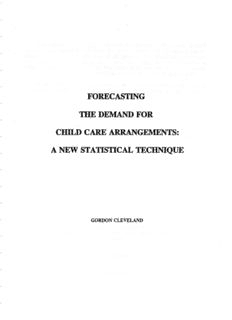
forecasting the demand for child care arrangements PDF
Preview forecasting the demand for child care arrangements
FORECASTING THE DEMAND FOR CHILD CARE ARRANGEMENTS: A NEW STATISTICAL TECHNIQUE GORDON CLEVELAND Funding from the Child Care Initiatives Fund of the Department of National Health and Welfare is gratefully acknowledged. Additional copies of the Handbook may be obtained from CH]LD CARE 2000, 297 St. George St., Toronto MSR 2P8 or from the Department of National Health and Welfare in Ottawa. Cette publication est aussi disponible en francais. Addressez-vous au CHILD CARE 2000, 297 St. George St., Toronto M.SR 2P8 ou au Ministère de la Santè et du Bien-Etre à Ottawa. The views expressed herein are solely those of the author and do not represent the views or policy of the Department of National Health and Welfare or of DIRECTION 2000. PROJECT SPONSORED BY DIRECTION 2000: DEVELOPING COMMUNITY DAY CARE TORONTO APRIL, 1992 © Gordon Cleveland TABI OF CONTENTS List of Tables ............................................................. ,, ....... iii List of Charts ............................................................. .. ....... v Acknowledgements ............................................................. vii Executive Summary ............................................................. ix CHAPTER 1. Introduction ............................................................... 2. Need, Preference and Demand: Current Methods of Measuring the Desire for Additional Child Care Facilities ................................................................... 5 3. A New Method of Measuring and Forecasting Parents' Choice of Child Care Arrangements: A General Overview..., ...... 17 4 . How to Measure and Forecast Demand for Child Care Arrangements: A Concrete Example ...................... ....... 29 5. Getting the Measurement Right: Using Statistical Tests to Improve Estimates of Child Care Choice ....................... 5 5 6. Forecasting the Number of Mothers in the Paid Labour Force Needing Some Type of Child Care Arrangement ........... 63 7. Concluding Observations .......................................... 6 7 APPENDICES A . Computer Software and Hardware for Estimating Logit Models ...................................... , ............................... 69 B. How to Use the 1988 National Child Care Survey .......... 77 C. Brief Review of Studies of Child Care Choice ................. 85 D. Technical Details of the Multinomial and Conditional Logit Econometric models .................................................... 9 1 Selected Bibliography .......................................................... 97 Glossary .......................................................... , ................. 103 LIST OF TABLES Table 1 Mixed Logit Estimates: Choice of Day Care Centre, Sitter, or Care by Relative ......................................36 Table 2 Changes in the Probability of Choosing a Day Care Centre, Sitter and Relative due to Changes in Explanatory Variables at Sample Means ........... 45 Table 3 Changes in the Predicted Percentage of Families Choosing a Day Care Centre, Sitter and Relative due to Changes in Explanatory Variables ............. 47 Table 4 Policy Simulations on Full Data Set ...........48 Table 5 Percent of Families Choosing a Day Care Centre, Sitter and Relative as a Result of Changes Designed to Increase the Demand for Daycare ............. 51 Table 6 Test Statistics of Model Performance ........... 58 LIST OF CHARTS Chart 1 Predicted Probability of Day Care Choice by Two Parent Family, by Age of Child and Day Care Price..... 43 Chart 2 Percent of Families Choosing a Day Care Centre, Sitter and Relative as a Result of Changes Designed to Increase the Demand for Day Care ........... 52 ACKNOWLEDGEMENTS The Child Care Initiatives Fund of The Department of National Health and Welfare has supported the research, writing and production of this Handbook from the beginning. Sharon Gribbon, Project Officer, and Carol Levesque, Financial Officer, have been unfailingly helpful in shepherding this project through the bureaucratic maze, and deserve my warm thanks. Doug Hyatt wrote Appendix A on Computer Software and Hardware, made important contributions to Appendix B, and has provided insightful comment on the entire penultimate draft. Morley Gunderson, Gordon Anderson, and Michael Denny have helped improve my understanding of Iogit models and their interpretation. They should not be held responsible for my use or abuse of this knowledge. A Project Committee from various parts of the country has met twice, has reviewed and commented on drafts of the material. Their contributions have been collectively and individually invaluable and have made this Handbook a different, and more readable, product than it would have been. Lyse Frenette from Montreal, Brian Powell from Ottawa, Jane Bertrand and Petr Varmuza from Toronto, Mary Humphrey from Winnipeg, and Peter Ashmore from Vancouver deserve considerable credit for their unremunerated but not unappreciated labours. My thanks, too, to Sonia Ostrowska and Penney Kirby -- who helped organize and staff the Project Committee meetings and who laboured secretarially. Sue Colley provided advice, criticism, and much secretarial labour, too. Gilbert Bélisle has spent more time than perhaps he would have wished learning the vocabulary of statistics and economics in order to transform a document written originally in English into a very natural French translation. He has been unfailingly efficient and co-operative in this endeavour. This project, formally called The Child Care Demand Forecasting Project, has been sponsored by DIRECTION 2000, a non-profit organization which develops new day care services and provides research and other services which contribute to the development of day care. Lorraine Duff, as the Executive Member in charge of the project, has kept me on the straight and narrow way, monitoring the progress of the Handbook, signing cheques as needed, and ensuring the provision of reports to the Board from time to time. Evelyn McKee has handled the financial side of my relationship with DIRECTION 2000 with infinite patience and good humour and considerable hours of labour. Sharron Richards and the rest of the Board of DIRECTION 2000 deserve credit for their willingness to champion a project which must have seemed occasionally to be only distantly related to the concrete task of building a better system of day care for our children. I hope the result will justify their trust.
Description: